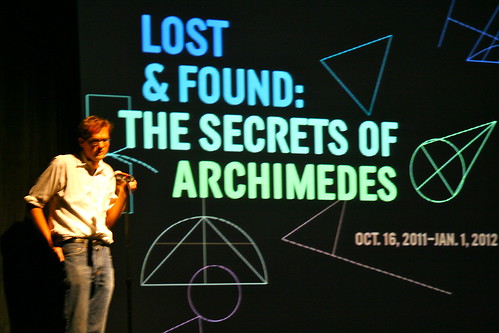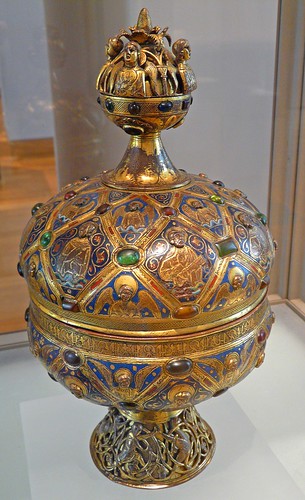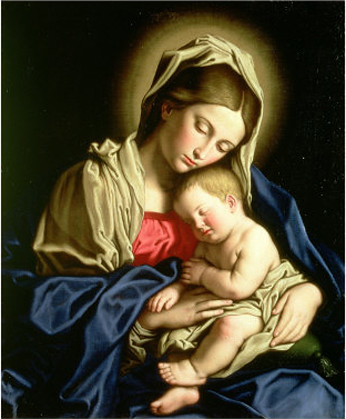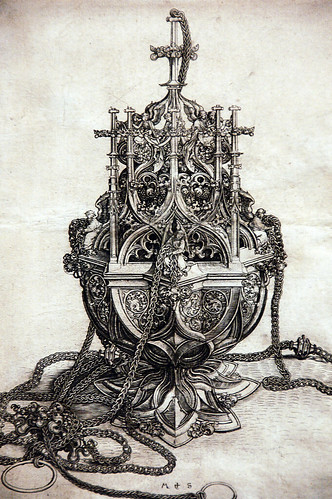Thursday, November 24, 2011
The Archimedes Palimpsest Publications
Wednesday, November 2, 2011
NOV 12: Archimedes Palimpsest Lectures at The Walters
The Conservation, Imaging, and Scholarship on the Archimedes Palimpsest,
Featuring Abigail Quandt, Reviel Netz, and Roger Easton.
The Walters Art Museum
Baltimore
Hear about groundbreaking techniques that saved the earliest surviving Archimedes manuscript, revealing much of what this Greek mathematician sketched in sand in Syracuse in the 3rd century B.C. The panel includes Stanford University Professor and historian of pre-modern mathematics, Reviel Netz, the co-author with Will Noel of The Archimedes Codex (2007); RIT imaging scientist Roger Easton; Walters conservators Abigail Quandt and Glenn Alan Gates, and Will Noel as moderator.
Wednesday, October 19, 2011
Lost and Found: The Secrets of Archimedes
Saturday, September 24, 2011
Carrow Psalter, Sailors throw Jonah overboard/Jonah in mouth of whale, Walters Manuscript W.34, fol. 131r
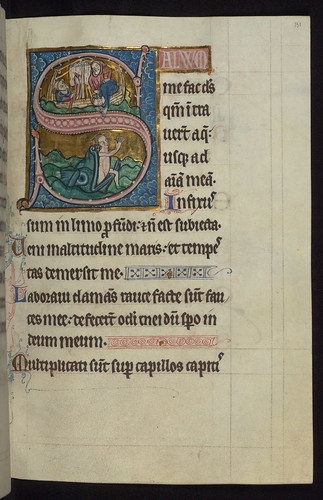
Carrow Psalter, Sailors throw Jonah overboard/Jonah in mouth of whale, Walters Manuscript W.34, fol. 131r, originally uploaded by Walters Art Museum Illuminated Manuscripts.
This English manuscript was made in East Anglia in the mid-thirteenth-century for a patron with special veneration for St. Olaf, whose life and martyrdom is prominently portrayed in the "Beatus" initial of Psalm 1. Known as the "Carrow Psalter," due to its later use by the nunnery of Carrow near Norwich, it is more accurately described as a Psalter-hours, as it contains the Office of the Dead, the Hours of the Virgin, and Collects. The manuscript is striking for its rich variety of illuminations, including full-page cycles of saints, martyrs, and Biblical scenes, as well as historiated initials within the Psalter, and heraldry added in the fifteenth-century to undecorated initials in the Hours of the Virgin. Especially notable is the miniature portraying the martyrdom of St. Thomas Becket, for after Henry VIII found him guilty of treason in 1538, his image was concealed by gluing a page over it, rather than destroying it, and it has since been rediscovered.
Wednesday, September 21, 2011
Monday, September 19, 2011
The Archimedes Palimpsest Exhibition
Opening imminently at The Walters Art Museum, Baltimore
Sunday, September 11, 2011
Illuminated Manuscript, Saints' Lives, Walters Art Museum Ms. W.71, fol. 51r
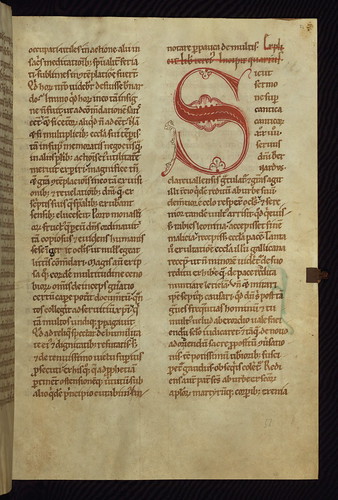
Illuminated Manuscript, Saints' Lives, Walters Art Museum Ms. W.71, fol. 51r, originally uploaded by Walters Art Museum Illuminated Manuscripts.
This manuscript, which was made at or for the Cistercian monastery at Himmerode, Germany, is a compilation of several texts written in the late twelfth or early thirteenth century. The first and third texts, William of St. Thierry's "Life of St. Bernard" and Hugh of St. Victor's "On the Lamentations of Jeremiah," are contemporary but were written separately and then bound together. A third text, Jacques de Vitry's Life of St. Marie d'Oignies, was inserted in between them at a later time. Several additional texts were added to blank pages in the thirteenth century, most notably a letter by Hildegard on the final folio. Many different hands can be identified throughout the manuscript, sometimes changing every few lines, and this variety of scribes is especially evident in the third text. Although the book contains no pictorial illuminations, large ornate foliate initials, drawn in bright green and red, announce the beginning of each chapter.
Ethiopian Manuscript, Gondar Homiliary, Walters Manuscript W.835, fol. 10v
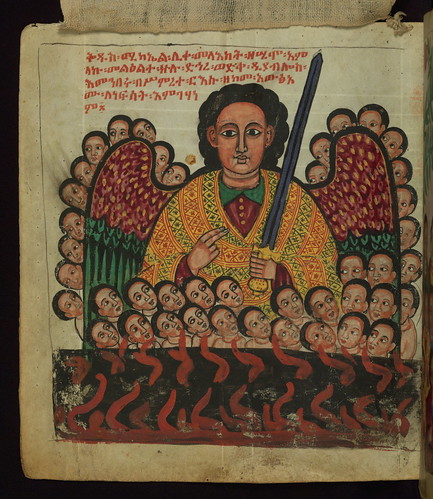
Ethiopian Manuscript, Gondar Homiliary, Walters Manuscript W.835, fol. 10v, originally uploaded by Walters Art Museum Illuminated Manuscripts.
This Homiliary was created in Gondar, Ethiopia during a period of artistic flowering in the late seventeenth century. The Imperial court and its accompanying aristocracy took up permanent residence in Gondar at this time, and the taste of these wealthy patrons for paintings and extensive image cycles is exemplified by this richly illuminated manuscript. The text, a Homiliary focused on the miracles of the Archangel Michael, combines liturgical readings with forty-nine brightly colored renderings of God, St. Michael, and the miracles related in the text. Sections of the manuscript would have been read aloud on monthly feast days of the Archangel, and the images would have punctuated the readings. The artists were likely trained as painters, rather than solely manuscript illuminators, and their art can therefore be linked stylistically to contemporary mural painting.
Here St. Michael Rescues the Faithful from the Flames of Hell.
Wednesday, September 7, 2011
Psalter, The Fool speaking to God; two hounds chasing a rabbit marginal decoration, Walters Manuscript W.79, fol. 56r
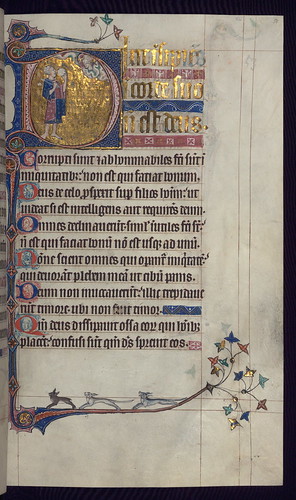
Psalter, The Fool speaking to God; two hounds chasing a rabbit marginal decoration, Walters Manuscript W.79, fol. 56r, originally uploaded by Walters Art Museum Illuminated Manuscripts.
This English Psalter was made for an East Anglian patron at the beginning of the fourteenth century. The original Psalter contains a calendar for adapted Sarum use, the Psalms, Canticles, Litany, and Office of the Dead, with additional prayers in a humanist hand added by a fifteenth century owner. The text is incomplete; about two-dozen leaves have been removed, resulting in missing historiated initials, and several partial Psalms and Canticles. Three extant historiated initials, accompanied by incipits in gold, stand out among a multitude of smaller painted and flourished initials. The majority of the text is written in accomplished textualis prescissa. This Psalter has stylistic and textual connections to the Gorleston Psalter (British Library Add. 49622) and the Ormesby Psalter (Bodl. Lib., Douce MS 366), placing it firmly within the tradition of East Anglian manuscript production in the first half of the fourteenth century.
Tuesday, August 23, 2011
Illuminated Manuscript, Bible Pictures by William de Brailes, Lot and his Family Flee Sodom, Walters Art Museum Ms. W.106, fol. 4r

Illuminated Manuscript, Bible Pictures by William de Brailes, Lot and his Family Flee Sodom, Walters Art Museum Ms. W.106, fol. 4r, originally uploaded by Walters Art Museum Illuminated Manuscripts.
In honor of the Great East Coast Earthquake of 2011, I give you this wonderful scene of destruction from the thirteenth century!
Tuesday, August 16, 2011
Les livres du gouvernement des roys et des princes, Seated prince conversing with scholar, Walters Manuscript W.144, fol. 35v
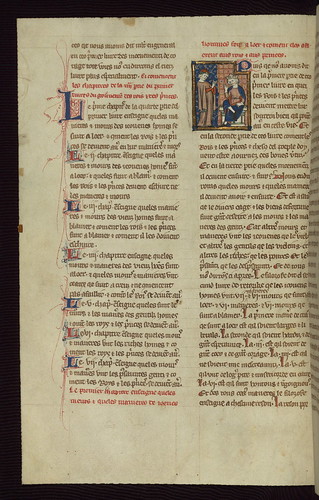
Les livres du gouvernement des roys et des princes, Seated prince conversing with scholar, Walters Manuscript W.144, fol. 35v, originally uploaded by Walters Art Museum Illuminated Manuscripts.
This early fourteenth century English manuscript is an example of Henri de Gauchy’s French translation of De regimine principum. Giles of Rome first composed the text in Latin for Philip of the Fair around 1277, and it was soon translated into several vernacular languages. Henri de Gauchy’s was the most prolifically copied of the French translations, and remains extant in thirty-one copies, only six of which are of English origin. The quality of the illumination in Walters 144 suggests that this book was destined for a king or member of the nobility, though it has no evidence of ownership prior to 1463. The text is divided into three books, intended to instruct princes on his ethical, economical and political responsibilities: the conduct of the individual, the rule of the family and household, and the governance of the kingdom. Scenes of princes and scholars conversing, and princes instructing their subjects are among the ten miniatures and historiated initials. The book is a member of the Queen Mary Psalter group (BL Royal 2 B VII).
Saturday, August 13, 2011
Illuminated Manuscript, Gospels of Abbot Duden, Evangelist portrait of Luke, Walters Art Museum W.5, fol.59v
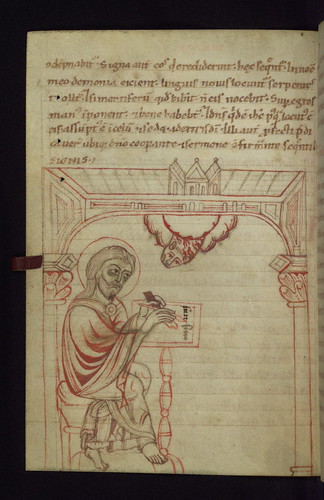
Illuminated Manuscript, Gospels of Abbot Duden, Evangelist portrait of Luke, Walters Art Museum W.5, fol.59v, originally uploaded by Walters Art Museum Illuminated Manuscripts.
This small Gospel Book was made in Werden, Germany in the eleventh century. Its small size indicates it was intended for daily, personal use, and a series of ownership inscriptions on the first folio, which trace how the book changed hands among several members of the clergy, provide insight into its use. Although the book contains little decoration, with no canon tables or ornamental initials, the Gospels are introduced by three accomplished brown and red ink pen drawings of the Evangelists, two of which were cleverly embedded into the end of the previous Gospel by the artist. The manuscript is, however, incomplete, and lacks the end of Matthew as well as the portrait of Mark, which was likely incorporated into Matthew's explicit page as was done with the other portraits.
Tuesday, August 9, 2011
An Ottoman Map - Of England
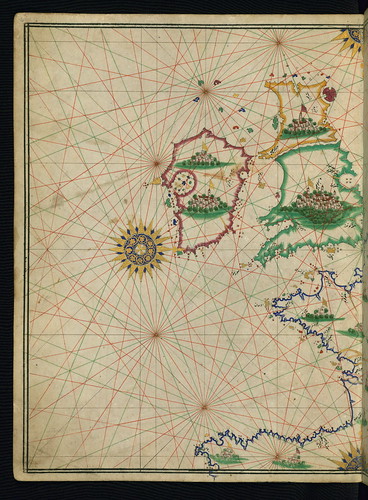
Illuminated Manuscript, Maritime atlas, Walters Art Museum Ms. W.660, fol.5a, originally uploaded by Walters Art Museum Illuminated Manuscripts.
Illuminated Manuscript, Maritime atlas, Walters Art Museum Ms. W.660, fol.5a
This is an illuminated and illustrated maritime atlas, referred to as the Walters Deniz atlası. It is an early Ottoman atlas, perhaps dating to the tenth century AH / sixteenth CE. The work contains eight double-page charts executed on parchment. Four of the maps show the Mediterranean, Aegean, and Black seas. There is also a world map and a chart of the Indian Ocean. The various geographical names are written in black nastaʿlīq script. A distinguishing feature of this atlas is the detailed approach to representing such features as city vignettes.
Sunday, July 31, 2011
Ethiopian Gospels, Diagram showing how the Four Gospels agree in words, Walters Manuscript W.836, fol. 6r
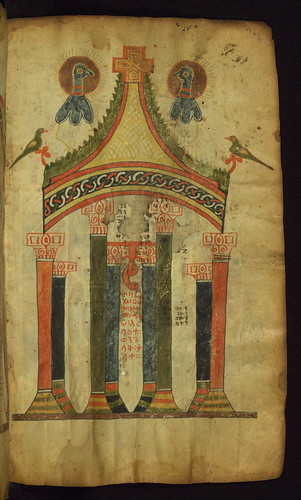
Ethiopian Gospels, Diagram showing how the Four Gospels agree in words, Walters Manuscript W.836, fol. 6r, originally uploaded by Walters Art Museum Illuminated Manuscripts.
This Gospel book was written in Tǝgray, Northern Ethiopia, in the early fourteenth century, and was once owned by the church of St. George in Däbrä Mä‛ar. It is written by the scribe Mäṭre Krǝstos in the official liturgical language of Ethiopia, Gǝ‛ǝz. Most notable is its prefatory image cycle, which makes references to holy places in Jerusalem, such as Golgotha and the Holy Sepulcher, as they appeared in the sixth century. The manuscript therefore appears to be based on a sixth-century exemplar containing images connected to the Byzantine cult of holy places. Several related manuscripts have been identified that seem to be based on the same prototype, most notably Paris, Bibliotheque Nationale eth. 32, a fragment in the Institute of Ethiopian Studies, Addis Ababa University, Ethiopia, Inventory No. 3475 a-b, and another fragment in the Nationalmuseum, Stockholm, NM B 2034. The Paris manuscript contains a mid-fourteenth-century colophon which helps date the group. Although water has damaged some of its elaborately decorated pages, this Gospel Book is still an important record of the resurgence of monasticism that flourished in fourteenth-century Ethiopia.
Saturday, July 23, 2011
Illuminated Manuscript, Album of Indian miniatures and Persian calligraphy, Walters Art Museum Ms. W.669, fol.7a
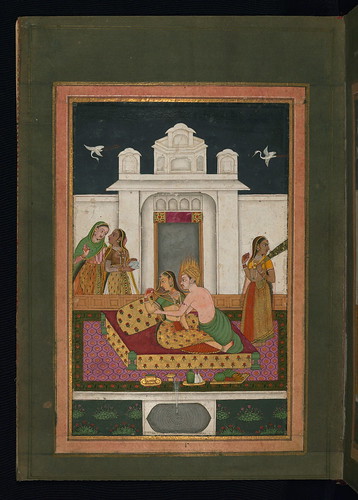
Illuminated Manuscript, Album of Indian miniatures and Persian calligraphy, Walters Art Museum Ms. W.669, fol.7a, originally uploaded by Walters Art Museum Illuminated Manuscripts.
What a wonderful way to visualize a melodic mode:
This is an album (muraqqaʿ) compiled in the late thirteenth century AH / nineteenth CE, or possibly later. It contains nineteen Deccani paintings and four pages of shikastah calligraphy (fols. 3b, 7b, 8a, and 9b), one of which is dated 1211 AH / 1796 CE (fol. 3b). The paintings, which date to the late twelfth century AH / eighteenth CE or thirteenth century AH / nineteenth CE, come from a ragmala series attributable to the Deccan. A ragmala is a visualization of a musical mode or melody. This album contains a mix of visualizations of ragas (male musical modes) and raginis (female musical modes considered to be the wives of the male musical modes). The codex was formerly in an accordion format, and the multicolor flexible cloth hinges on the leaves are still visible. It was later rebound in a brown goatskin binding with a central lobed oval.
Thursday, July 21, 2011
Gospel Lectionary, Saint Matthew writing his Gospel, inspired by Wisdom, Walters Manuscript W.535, fol. 67v
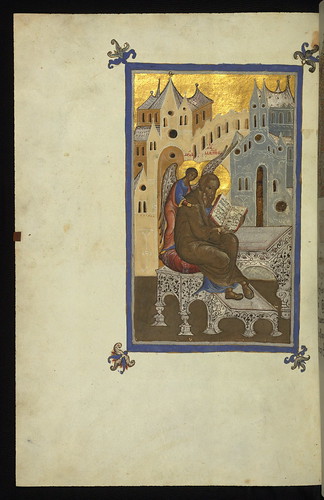
Gospel Lectionary, Saint Matthew writing his Gospel, inspired by Wisdom, Walters Manuscript W.535, fol. 67v, originally uploaded by Walters Art Museum Illuminated Manuscripts.
This is one of twenty-six known manuscripts by the hand of Luke the Cypriot (active 1583-1625), an accomplished Greek calligrapher who worked after the Ottoman conquest of Constantinople (1453). He copied it in 1594 at his episcopal see of Buzǎu (in Wallachia, now Romania) and soon took it to Moscow, where it was richly illustrated with New Testament scenes by a team of anonymous Russian artists. The book contains passages taken from the four Gospels and arranged in the order in which they are read out loud in church in the course of the year (hence its name Lectionary, from the Latin "lectio," reading). Short intructions in Slavonic accompany some of the miniatures, offering a glimpse of the painters' working process.
Tuesday, July 19, 2011
Monday, July 18, 2011
Digitizing History
Books and Other Fetsh Objects
Sunday, July 17, 2011
Missal of Eberhard von Greiffenklau, Nativity, Walters Manuscript W.174, fol. 17v

Missal of Eberhard von Greiffenklau, Nativity, Walters Manuscript W.174, fol. 17v, originally uploaded by Walters Art Museum Illuminated Manuscripts.
The Missal of Eberhard von Greiffenklau is a masterpiece of Dutch manuscript painting. It was originally produced in the second quarter of the fifteenth century for von Greiffenklau, prebendary of Utrecht from 1446. The manuscript features work by the Masters of Zweder van Culemborg, active in the Utrecht area between 1420 and 1440, so-named after the Bishop of Utrecht 1425-33 for whom they produced a magnificent Missal in the late 1420s (now Bressanone, Bibl. del Seminario Maggiore). This Missal also features work by the celebrated Master of Catherine of Cleves, linking it to possibly the finest Dutch illuminated manuscript ever made; the Hours of Catherine of Cleves of c.1440 (Morgan Library & Museum, M.917 & M.945). This extremely elaborate Missal is illuminated with one full-page miniature, 52 column miniatures and 68 historiated initials throughout the manuscript, with the Temporal and Sanctoral sections being particularly richly decorated. In the late 15th century, a selection of prayers and sequences were added to the end of the manuscript in Germany, probably Mainz, and the volume was subsequently rebound with its current brown calf over boards, blind, rebacked binding either at that time or in the early 16th century.
Tuesday, July 12, 2011
A New Digital Resource for Historians of Islamic Art and Culture: The Islamic Manuscripts of the Walters Art Museum
With the help of a Preservation and Access Grant from the National Endowment for the Humanities, and with additional funding from an anonymous donor, the Walters is pleased to announce the completion of its program to create digital surrogates of its collection of Islamic manuscripts and single leaves. All the data is licensed for use under Creative Commons Attribution-NonCommercial-ShareAlike 3.0 UnportedAccess Rights, http://creativecommons.org/licenses/by-nc-sa/3.0/legalcode. Images are free for any noncommercial use, provided you follow the terms of the license. There is no need to apply to the Walters prior to using the images.
Sunday, July 10, 2011
Illuminated Manuscript, The Rochester Bible, Walters Art Museum Ms. W.18, fol.146r
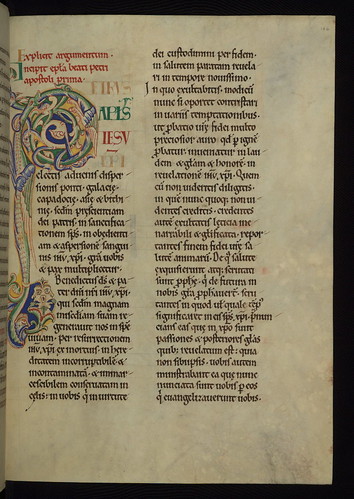
Illuminated Manuscript, The Rochester Bible, Walters Art Museum Ms. W.18, fol.146r, originally uploaded by Walters Art Museum Illuminated Manuscripts.
This large-format copy of the New Testament was created at, and for, Rochester Cathedral in Rochester, England in the first half of the twelfth century. The manuscript is an important survival, for it is one part of what is believed to be the the earliest decorated Bible produced at the priory scriptorium at Rochester. Originally a five volume work, only one other volume, British Library, Royal I.C.VII., has survived. The book's large size indicates it was designed to be read aloud, either during services or at meals. Large, fanciful initials filled with foliage, dragons, and human faces begin each section of the text, and their vibrant color and intricate designs capture the essence of Romanesque manuscript illumination.
Initial "P" opening the First Epistle of St. Peter the Apostle.
Saturday, July 9, 2011
Amida Gospels, Walters Art Museum, Ms W.541, fol. 112v

Illuminated Manuscript, Amida Gospels, Walters Art Museum, Ms W.541, fol. 112v, originally uploaded by Walters Art Museum Illuminated Manuscripts.
This highly decorated Gospel Book was made in Armenia in the early seventeenth century. An extensive colophon reveals that it was commissioned by a woman named Napat' as a memorial for herself and her family, and the book was consequently given by her to the Church of Saint Sargis in Amida. The artist, Hovannes, and the scribe, Melk'on, are known collaborators on a number of of other manuscripts, and this book is an excellent example of their skill. Richly painted Evangelist portraits and intricate canon tables are complimented by simpler marginal illuminations that often connects to the Gospel passages they adorn. Related manuscripts by this artist and scribe team include Erevan, Matenadaran, no. 1245, and London, British Museum, Add. Ms. 27, 301. Portrait of the Evangelist Luke.
Saturday, July 2, 2011
Four leaves from the Arabic version of Dioscorides' De materia medica, Wild cucumber, Walters Manuscript W.750Aa
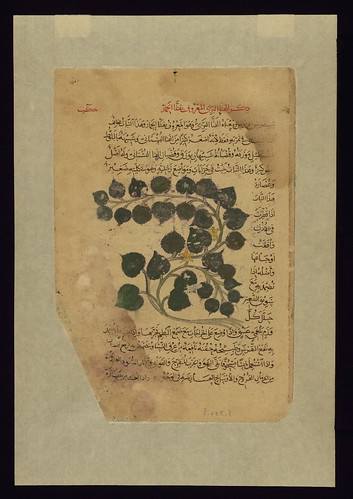
Four leaves from the Arabic version of Dioscorides' De materia medica, Wild cucumber, Walters Manuscript W.750Aa, originally uploaded by Walters Art Museum Illuminated Manuscripts.
One of four consecutive leaves (numbered fols. 237-241) from an illustrated manuscript of the Arabic version of De materia medica by Dioscorides, copied in the seventh century AH / thirteenth CE in Iran. Pedanius Dioscorides wrote his treatise on medicinal plants in the first century CE. It was translated into Syriac and then Arabic in Baghdad in the third century AH / ninth CE. De materia medica by Dioscorides was one of the earliest scientific manuscripts to be translated from Greek to Arabic. The Walters' leaves illustrate five plants: wild cucumber, mezereon (spurge-olive), and three varieties of thymelaea (spurge-laurel).
Tuesday, June 28, 2011
Illuminated Manuscript, Claricia Psalter, Walters Art Museum Ms. W.26, fol.64r
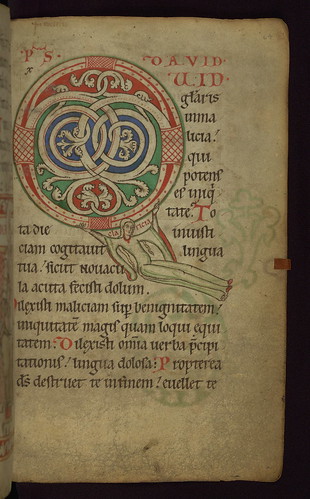
Illuminated Manuscript, Claricia Psalter, Walters Art Museum Ms. W.26, fol.64r, originally uploaded by Walters Art Museum Illuminated Manuscripts.
This Psalter was made for, and most likely by, a group of Benedictine nuns at the Abbey of Saints Ulrich and Afra in Augsburg, Germany. Although the Psalter itself, along with its calendar, date to the late twelfth or early thirteenth century, a number of texts and prayers were added in the mid thirteenth century. Most striking about the manuscript are its illuminations, which include a prefatory cycle, full-page miniatures and historiated initials. While all are Romanesque in style, they vary greatly in quality and technique, and three or four different artists seem to have been at work. The Claricia Psalter takes its name from one of the initials, which depicts a young girl in secular dress swinging from the initial "Q," who has "Claricia" written around her head. It has been suggested that the image represents a novice artist who signed her work, but there are many other theories, and none are certain.
"Claricia" swinging on foliate initial "Q" at the opening of Psalm 51.
Tuesday, May 31, 2011
Illuminated Manuscript, Conrad of Hirsau's Speculum Virginum, Tree of Virtues, Walters Art Museum Ms. W.72, fol. 26r
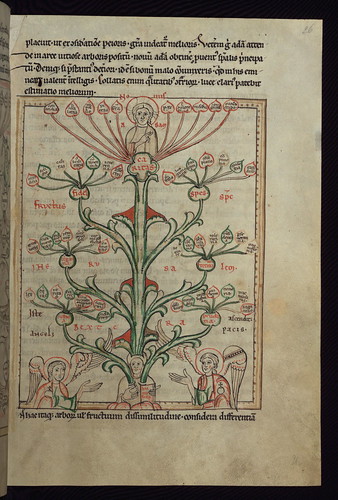
Illuminated Manuscript, Conrad of Hirsau's Speculum Virginum, Tree of Virtues, Walters Art Museum Ms. W.72, fol. 26r, originally uploaded by Walters Art Museum Illuminated Manuscripts.
This manuscript, written at the Cistercian abbey of Himmerode in Germany in the early thirteenth century, is one of twenty-two surviving Latin copies of the Speculum Virginum, or Mirror for Virgins. Attributed to Conrad of Hirsau, the text was written in the first half of the twelfth century as a guide for nuns, and offered them theological lessons in the form of a hypothetical conversation between a teacher, Peregrinus, and his student, Theodora. The twelve illustrations in the manuscript portray the protagonists as well as the mystical visions and diagrams they discuss in the text. The large, expressive pen drawings bring the text to life, and are an excellent example of German art of this period.
Saturday, May 14, 2011
Illuminated Manuscript, De Rectoribus Christianis, Decorated Initial, Walters Art Museum, Ms W.12, fol. 9v

Illuminated Manuscript, De Rectoribus Christianis, Decorated Initial, Walters Art Museum, Ms W.12, fol. 9v, originally uploaded by Walters Art Museum Illuminated Manuscripts.
Created in the mid-twelfth century in Germany, this manuscript contains the much earlier writings of the Irish scholar Sedulius Scotus. Writing in the mid-ninth century at St. Lambert in Liege, Scotus famously penned this treatise on the duties and ideals of the Christian king or prince, and it is the earliest version of a genre that would become popular in the later medieval and Renaissance periods, often known as "Mirrors for Princes." This manuscript is the second oldest copy of Scotus' treatise known, the earliest being the ninth century Bremen Stadtbibliothek C. 36. The text is virtually complete, missing only its first and last folios, and is written in a clear Romanesque Caroline script. The nine inhabited initials, which include dragons and cranes, as well as the seven foliate initials have been left unfinished.
Illuminated Manuscript, Koran, Incipit, Walters Art Museum, Ms W.563, fol. 9b
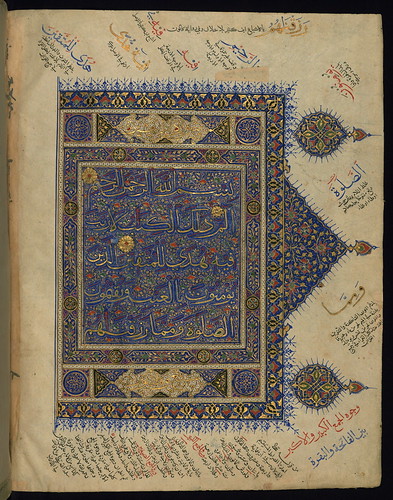
Illuminated Manuscript, Koran, Incipit, Walters Art Museum, Ms W.563, fol. 9b, originally uploaded by Walters Art Museum Illuminated Manuscripts.
This large-format, illuminated Timurid copy of the Qur’an is believed to have been produced in Northern India in the ninth century AH / fifteenth CE. The manuscript opens with a series of illuminated frontispieces. The main text is written in a large vocalized polychrome muḥaqqaq script. Marginal explanations of the readings of particular words and phrases are in thuluth and naskh scripts, and there is interlinear Persian translation in red naskh script. The fore-edge flap of the gold-tooled, brown leather binding is inscribed with verses 77 through 80 from Chapter 56 (Sūrat al-wāqiʿah). The seal of Sultan Bayezid II (1481-1512 CE) appears on fol. 8a. There is an erased bequest (waqf) statement and stamp of Sultan ʿUthmān Khān (1027-31 CE) on fol. 3a.
Friday, April 22, 2011
Illuminated Manuscript, Compendium of computistical texts, Above: Diagram of the harmony of the year and seasons; Below: Diagram of the harmony of the elements, seasons, and humors, Walters Art Museum Ms. W.73, fol. 8r
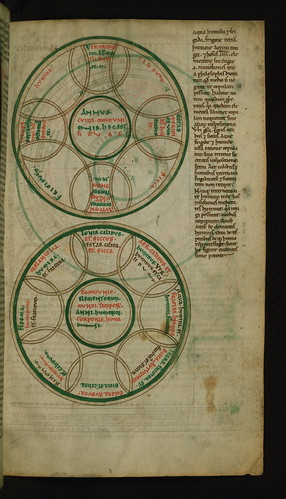
Illuminated Manuscript, Compendium of computistical texts, Above: Diagram of the harmony of the year and seasons; Below: Diagram of the harmony of the elements, seasons, and humors, Walters Art Museum Ms. W.73, fol. 8r, originally uploaded by Walters Art Museum Illuminated Manuscripts.
Created in England in the late twelfth century, this manuscript was intended to be a scientific textbook for monks. The manuscript is brief at nine folios, and was designed as a compendium of cosmographical knowledge drawn from early Christian writers such as Bede and Isidore, as well as the later Abbo of Fleury. Those writers, in turn, drew on classical sources like Pliny the Elder for their knowledge, but adapted it to be understood through the filter of Christianity. The twenty complex diagrams that accompany the texts in this pamphlet help illustrate them, and include visualizations of the heavens and earth, seasons, winds, tides, and the zodiac, as well as demonstrations of how these things relate to man. Although the exact grouping of texts and diagrams here is unique, the manuscript is related to other scientific compilations from this era, such as British Library, Royal Ms. 13 A.XI, Cotton Ms. Tiberius E.IV, and Oxford, St. John's College, Ms. 17.
Monday, April 4, 2011
Illuminated Manuscript, Melk Missal, Crucifixion, Walters Art Museum Ms. W.33, fol. 132v
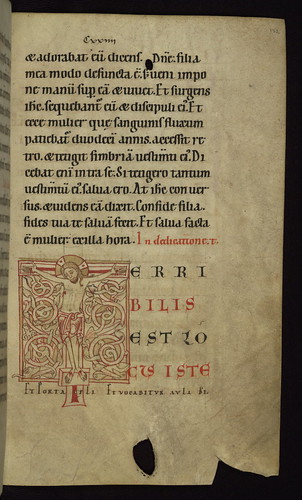
Illuminated Manuscript, Melk Missal, Crucifixion, Walters Art Museum Ms. W.33, fol. 132v, originally uploaded by Walters Art Museum Illuminated Manuscripts.
This missal, which dates to the late twelfth or early thirteenth century, was made for the Benedictine abbey of Melk or Seitenstetten in Upper Austria, as indicated by the inclusion of local saints and liturgy. The surviving volume of a multi-volume missal, the book contains only the "Summer Part," with the Temporal running from Holy Saturday through the Sunday after Trinity Sunday, and the Sanctoral beginning with the Nativity of St. John the Baptist and ending with St. Andrew. The manuscript lacks a calender, an element that was most likely included in one of the other volumes. Most notable about the manuscript are its skilled pen drawings, including two full-page miniatures depicting Christ in Majesty and the Crucifixion, as well as sixteen ornate initals, three of which are by the artist known as Gottschalk of Lambach. The binding, although later and dating to the fifteenth century, is also notable, for it contains inscriptions impressed with movable type.
Thursday, March 31, 2011
Illuminated Manuscript, Reichenau Gospels, Evangelist portrait of Matthew, Walters Art Museum Ms. W.7, fol. 15v

Illuminated Manuscript, Reichenau Gospels, Evangelist portrait of Matthew, Walters Art Museum Ms. W.7, fol. 15v, originally uploaded by Walters Art Museum Illuminated Manuscripts.
This Gospel book is believed to come from the Abbey of St. Peters in Reichenau, on the basis of its script, its illumination, and the fact that it contains a dedication image, in which a book is being handed to St Peter. The decoration of the manuscript places it in the so-called Luithar school of Reichenau. Its ornamental motifs compare very closely with those in Munich, Clm. 4453, and its palette is nearly identical to that in the Reichenau manuscripts of the Bamberg Cathedral Treasury. Gold uncials begin each paragraph as well as the introductory words of each chapter, and are a distinct mark of Reichenau manufacture. Its text is written in Caroline minuscule, and it is paleographically related to Bamberg Mss, Bibl. 76 and 22, and also Munich Clm. 4454. As a whole, it is an excellent example of Ottonian book illumination.
Wednesday, March 30, 2011
Illuminated Manuscript, Ethiopian Gospels, Evangelist portrait of Mark, Walters Art Museum Ms. W.850, fol. 60v
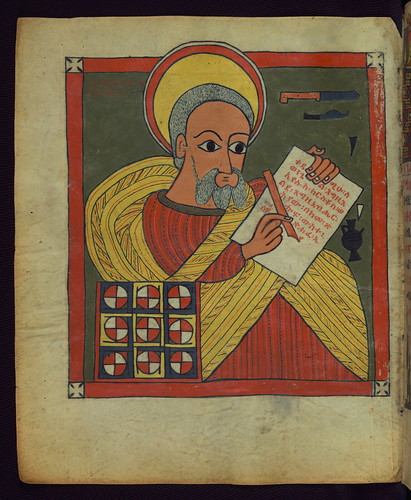
Illuminated Manuscript, Ethiopian Gospels, Evangelist portrait of Mark, Walters Art Museum Ms. W.850, fol. 60v, originally uploaded by Walters Art Museum Illuminated Manuscripts.
This large Ethiopian Gospel Book was made in the first half of the sixteenth century and is written in Ge'ez, the traditional liturgical language of the Ethiopian church. Containing eleven full-page miniatures, six canon tables and five elaborately ornamented harags, or headpieces, this manuscript represents the Golden Age of what has been termed the Gunda Gunde style, named after a monastery in the town of Agame. The Gunda Gunde style is characterized by bold blocks of color defined by detailed and often delicate linear motifs. Figures are highly stylized and expressive, while the accompanying canon tables and harags are filled with intricate interlace and geometric forms. The manuscript is exceptionally well preserved, and is an excellent and rare example of Ethiopian illumination from one of its most important artistic centers.
Thursday, March 17, 2011
Illuminated Manuscript, Book of Hours, Veronica with the Sudarium, Walters Art Museum Ms. W.165, fol. 107v
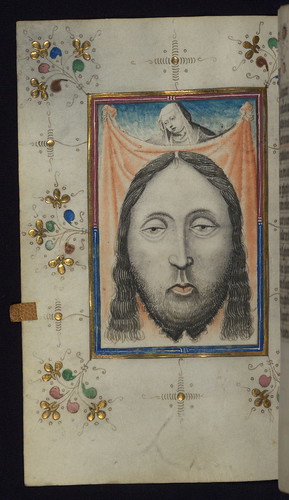
Illuminated Manuscript, Book of Hours, Veronica with the Sudarium, Walters Art Museum Ms. W.165, fol. 107v, originally uploaded by Walters Art Museum Illuminated Manuscripts.
Illuminated Manuscript, Book of Hours, Veronica with the Sudarium, Walters Art Museum Ms. W.165, fol. 107v
This mid-fifteenth century illuminated Book of Hours is written entirely in Dutch on fine vellum, and is remarkable for its eighteen grisaille miniatures. The technique, wherein the figures are modeled primarily in a gray wash, became a favorite in the Netherlands, and the hand behind the paintings in this manuscript has been identified with a group of artists known as the "Masters of the Delft Grisailles." This manuscript has been grouped with more than a dozen related works, including New York PML M. 349, London, Victoria and Albert Geo. Reid Ms. 32, Leiden B.P.L. 224, Brussels, BR 21696, Antwerp, Plantein Moretus Ms. 49, and the Hague K.B. Ms. 74 G 35. The manuscript is comprised of 152 folios and is almost completely intact, lacking only two miniatures, and retains its original brown leather binding decorated with mythological beasts and a now illegible inscription. The calendar is for the use of Utrecht, which helps localize its original ownership, as might a mostly erased ownership inscription that has been partially recovered by Marrow. The illumination begins the prayer to the holy face.
Wednesday, March 16, 2011
Illuminated Manuscript, Map of Premuda (Premūde Venedīk) island west off the Pag Island (Croatia) from Book on Navigation, Walters Art Museum Ms. W.658, fol.164a
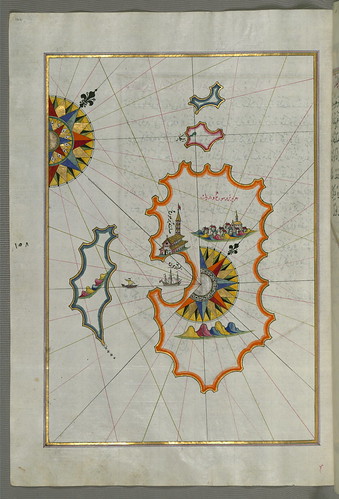
Illuminated Manuscript, Map of Premuda (Premūde Venedīk) island west off the Pag Island (Croatia) from Book on Navigation, Walters Art Museum Ms. W.658, fol.164a, originally uploaded by Walters Art Museum Illuminated Manuscripts.
Illuminated Manuscript, Map of Premuda (Premūde Venedīk) island west off the Pag Island (Croatia) from Book on Navigation, Walters Art Museum Ms. W.658, fol.164a
Originally composed in 932 AH / 1525 CE and dedicated to Sultan Süleyman I ("The Magnificent"), this great work by Piri Reis (d. 962 AH / 1555 CE) on navigation was later revised and expanded. The present manuscript, made mostly in the late 11th AH / 17th CE century, is based on the later expanded version with some 240 exquisitely executed maps and portolan charts. They include a world map (fol.41a) with the outline of the Americas, as well as coastlines (bays, capes, peninsulas), islands, mountains and cities of the Mediterranean basin and the Black Sea. The work starts with the description of the coastline of Anatolia and the islands of the Aegean Sea, the Peloponnese peninsula and eastern and western coasts of the Adriatic Sea. It then proceeds to describe the western shores of Italy, southern France, Spain, North Africa, Palestine, Israel, Lebanon, Syria, western Anatolia, various islands north of Crete, Sea of Marmara, Bosporus and the Black Sea. It ends with a map of the shores of the the Caspian Sea (fol.374a).
See this manuscript page by page at the Walters Art Museum website:
art.thewalters.org/viewwoa.aspx?id=19195
Comments and faves
Sunday, March 13, 2011
Corvey Gospel fragment, Incipit John's Gospel, Walters Art Museum Ms. W.751, fol. 3v

Corvey Gospel fragment, Incipit John's Gospel, Walters Art Museum Ms. W.751, fol. 3v, originally uploaded by Walters Art Museum Illuminated Manuscripts.
This manuscript consists of four folios from a Gospel Book that was likely made at the monastery of Corvey in Western Germany during the last quarter of the tenth century. Dating to the reign of Otto I, these pages offer a magnificent example of early Ottonian manuscript illumination. The heavily ornamented pages, which introduce the Gospels of Luke and John, shine with gold and jewel-like colors against dyed purple grounds. These pages combine monumental classicizing square capitals on purple grounds with rich and complex interlace. This fragment contains the opening pages of Luke (fols. 93-94) and John (fols. 137-138) that were originally part of Ms. 10 from the Bibliotheque Municipale in Rheims, a Gospel Book originally owned by the Chapter Library of the Cathedral of Rheims until it was confiscated, along with the rest of the cathedral's manuscripts, during the French Revolution. Related manuscripts include Pierpont Morgan Library Ms. M. 755 and New York Public Library Ms. 1.
Wednesday, March 2, 2011
Archimedes Palimpsest
Vincent Carney frames a completely finished leaf Feb 26 2010
Thursday, February 24, 2011
Illuminated Manuscript, Gospels of Freising, Evangelist Portrait of Luke, Walters Art Museum Ms. W.4, fol. 126v
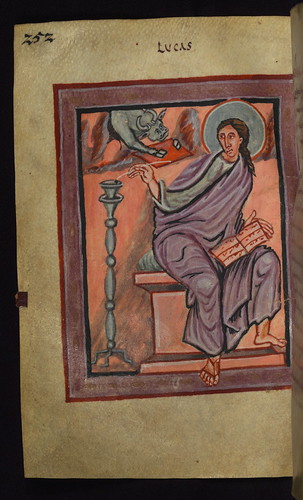
Illuminated Manuscript, Gospels of Freising, Evangelist Portrait of Luke, Walters Art Museum Ms. W.4, fol. 126v, originally uploaded by Walters Art Museum Illuminated Manuscripts.
This Gospel Book was written in Carolingian minuscule in the diocese of Freising, Germany ca. 875. Surprisingly small for an Gospel Book, it is nonetheless richly illuminated and offers an excellent example of Carolingian art. The expressive and emotive quality of the Evangelists, characterized by quick, sketchy brushwork, recalls the style developed by the Carolingian school of Reims in Northern France. This similarity may be attributed to a connection with Ebbo, the former Archbishop of Reims, since he fled to Freising at this time after a quarrel with Charles the Bald. The canon tables, however, derive from a different tradition, and recall Franco-Saxon imagery in its use of interlace within the columns, and of acanthus springing from the top corners. Due to these factors, the manuscript had once been attribution to Northern France, but it is now understood to be one of a group of related manuscripts from Freising during Ebbo's tenure. The manuscript is complete, consisting of 215 folios, and includes readings for the liturgical year, Jerome's Plures Fuisse and Novum Opus letters, decorated canon tables, and Evangelist portraits. The illumination is at the beginning of Luke's Gospel.
Friday, February 18, 2011
Illuminated Manuscript, Duke Albrecht's Table of Christian Faith (Winter Part), The Symbols of the Four Evangelists, Walters Art Museum Ms. W.171, fol. 156r

Illuminated Manuscript, Duke Albrecht's Table of Christian Faith (Winter Part), The Symbols of the Four Evangelists, Walters Art Museum Ms. W.171, fol. 156r, originally uploaded by Walters Art Museum Illuminated Manuscripts.
This illuminated manuscript is a document of the first importance in the history of Dutch manuscript illumination, and it contains an important medieval Dutch devotional text. The Tafel van den Kersten Ghelove is a compendium of Christian knowledge written by a learned Dominican, Dirc van Delf. The text is in two parts, one for winter, and one for summer. This manuscript is of the winter part, and it is incomplete, omitting the prologue and chapters 13,14, and 35-72. The arms of the Bavarian Counts of Holland and the kneeling owner on fol. 1 indicate that this manuscript was the actual copy prepared for the dedicatee of the text, Albrecht of Bavaria, Count of Holland, from the original text of his chaplain, and is therefore to be dated to 1404 at the latest, when Albrecht died. The manuscript consists of 165 folios and contains 35 historiated initials.
Monday, February 14, 2011
Illuminated Manuscript, Bible Pictures by William de Brailes, The first two days of Creation, Walters Art Museum Ms. W.106, fol. 1r
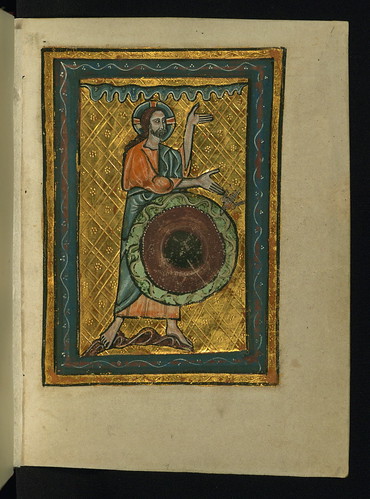
Illuminated Manuscript, Bible Pictures by William de Brailes, The first two days of Creation, Walters Art Museum Ms. W.106, fol. 1r, originally uploaded by Walters Art Museum Illuminated Manuscripts.
A volume comprising twenty-four leaves of Bible Pictures by W. de Brailes, an English artist active in Oxford in the middle of the thirteenth century. Seven leaves from the same set of images are now in the Musee Marmottan in Paris. These 31 leaves are all that remain of an image cycle that once contained at least 98 miniatures, and which was the longest cycle of Bible miniatures surviving from the thirteenth century in England. In all probability these Bible Pictures were actually prefatory matter to a Psalter, now Stockholm, National Museum, Ms. B.2010. De Brailes also composed and wrote the captions that accompany many of the images. W. de Brailes is one of only two English artists of the thirteenth century whose name we can associate with surviving works. 11 manuscripts have been identified that contain miniatures in his hand. De Brailes has a quirky and chatty style, and he was extremely gifted at turning Bible Stories into paint.
Sunday, February 6, 2011
Illuminated Manuscript Anthology of Persian poetry, Walters Art Museum Ms. W.653, fol. 17a
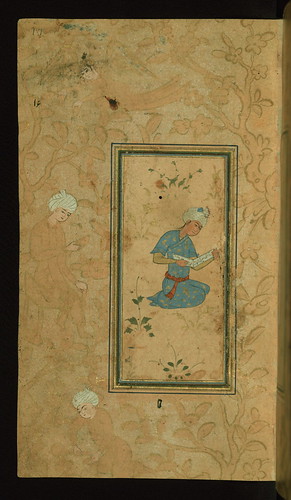
Illuminated Manuscript Anthology of Persian poetry, Walters Art Museum Ms. W.653, fol. 17a, originally uploaded by Walters Art Museum Illuminated Manuscripts.
This small anthology of Persian poetry consisting of poems by such authors as Jāmī, Azārī, Fayz̤ī, Navāʾī, and Saʿdī was put together by an anonymous scribe in 1105 AH / 1693 CE. Illustrated with six miniatures, the margins of this manuscript are embellished with stenciled designs of angels, men and animals. The page represents a seated young man reading from a book of Persian poetry.
See this manuscript page by page at the Walters Art Museum website:
art.thewalters.org/viewwoa.aspx?id=19402
Saturday, February 5, 2011
Wednesday, February 2, 2011
Illuminated Manuscript, Gospels, Walters Art Museum Ms. W.592, fol. 23a
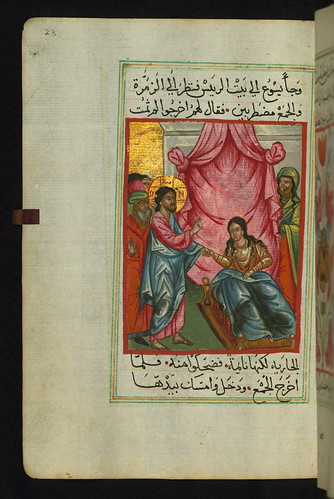
Illuminated Manuscript, Gospels, Walters Art Museum Ms. W.592, fol. 23a, originally uploaded by Walters Art Museum Illuminated Manuscripts.
This illuminated and illustrated Arabic manuscript of the Gospels by Matthew (Mattá), Mark (Marquṣ), Luke (Lūqā), and John (Yūḥannā) was copied in Egypt by Ilyās Bāsim Khūrī Bazzī Rāhib, who was most likely a Coptic monk, in Anno Mundi 7192 / 1684 CE. The text is written in naskh in black ink with rubrics in red. Jesus raises a ruler’s daughter from the dead.
Illuminated Manuscript Koran, The right side of a double-page excipit, Walters Art Museum MS. W.557, fol.284b

Illuminated Manuscript Koran, The right side of a double-page excipit, Walters Art Museum MS. W.557, fol.284b, originally uploaded by Walters Art Museum Illuminated Manuscripts.
This is the right side of an illuminated double-page excipit. The text is chapter 114 (Sūrat al-nās), which is written in a decorative New Abbasid (broken cursive) style.
Saturday, January 29, 2011
Ciborium of Maître Alpais
Ciborium of Maître Alpais, Limoges, gilded copper with champlevé enamel, glass cabochons, ca 1200
Ciboire du Maître Alpais, Limoges, émail champlevé sur cuivre doré, cabochons de verre
Friday, January 28, 2011
Madonna and Child by Sassoferrato
Madonna and Child
Sassoferrato
Giovanni Battista Salvi, called
(Sassoferrato 1605 - Rome 1685)
Madonna and Child, circa 1650
oil on canvas
Giovan Battista Salvi known, from his town of origin in the Marche, as Sassoferrato, shows the Madonna seated on the clouds with her feet resting on the half moon. She embraces the Child Jesus who holds in his hands a rosary that ends in a rose. Heads of cherubs rise from the clouds. The image confirms the stylistic elements that characterize his vast production of subjects of a religious nature: images of a solid formal layout with brilliant and almost enamelled colours.
Thursday, January 27, 2011
censer
Schongauer played an important role in the development of engraving in the latter half of the fifteenth century. This image of a censer- a container used to burn incense during mass- is one of the most celebrated prints he produced, not least for the precision of detail the work displays. Schongauer gave the object a degree of physical presence and illusionism entirely new to engraving of this period. It is likely that the print reproduced an existing object, though it may also have been executed as a model for goldsmiths.
Text excerpted from the Metropolitan Museum of Art label.
Schinkel, Karl Friedrich (1781-1841) - 1815 Gothic Cathedral with Imperial Palace (National Gallery, Berlin)

Schinkel, Karl Friedrich (1781-1841) - 1815 Gothic Cathedral with Imperial Palace (National Gallery, Berlin), originally uploaded by RasMarley.
German architect, painter, and designer, active mainly in Berlin. Schinkel was the greatest German architect of the 19th century, but until 1815, when he gained a senior appointment in the Public Works Department of Prussia (from which position he effectively redesigned Berlin), he worked mainly as a painter and stage designer. His paintings are highly Romantic landscapes somewhat in the spirit of Friedrich, although more anecdotal in detail (Gothic Cathedral by a River, Staatliche Museen, Berlin, 1813-14). He continued working as a stage designer until the 1830s, and in this field ranks among the greatest artists of his period. His most famous designs were for Mozart's The Magic Flute (1815), in which he combined the clarity and logic of his architectural style with a feeling of mystery and fantasy.
NYC - Fort Tryon Park - The Cloisters - Aquamanile in the form of a Cock
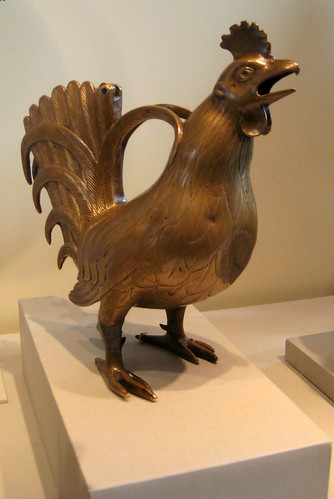
NYC - Fort Tryon Park - The Cloisters - Aquamanile in the form of a Cock, originally uploaded by wallyg.
Aquamanile in the Form of a Cock
Copper alloy
Germany, Lower Saxony, 13th century
The Cloisters Collection, 1989 (1989.292)
Former owner: Walter Randall, Paris and New York
Aquamanilia, from the Latin words meaning "water" (aqua) and "hands" (manus), were animal- or human-shaped water vessels used to pour water over the hands of priests before celebrating Mass and of diners at meals, usually cast in copper alloy through lost-wax process.
Aquamanilia in the form of roosters are rare, but this one can be related to two other examples, all strikingly naturalistic, with densely engraved feather patterns over much of their surfaces. Only in this example, however, was the modeler bold enough to balance the bird on its feet. In other examples, the tail feathers were extended to create a tripod for greater stability.
Collection of poems (masnavi), Walters Art Museum Ms. W.625, fol. 204b
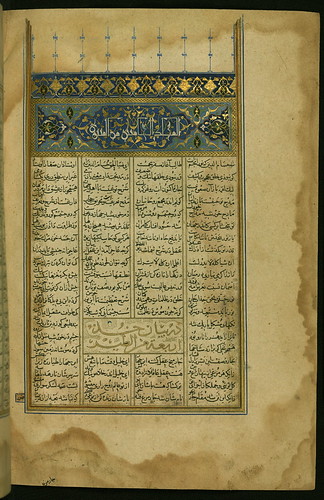
Collection of poems (masnavi), Walters Art Museum Ms. W.625, fol. 204b, originally uploaded by Walters Art Museum Illuminated Manuscripts.
Floral and foliate decoration in gold. Leaf from an elegantly calligraphed and illuminated copy of the collection of poems, known as Mas̱navī-i maʿnavī, by Jalāl al-Dīn Rūmī (d.672 AH / 1273 CE). This codex was penned by Aḥmad ibn Ḥājjī Abī Bakr al-Kātib in 865 AH / 1461 CE.
See this manuscript page by page at the Walters Art Museum website:
art.thewalters.org/viewwoa.aspx?id=22125
Monday, January 24, 2011
Illuminated Manuscript of One Hundred Sayings, Opening decorated page with headpiece, Walters Art Museum, Ms. W.615, fol.1b
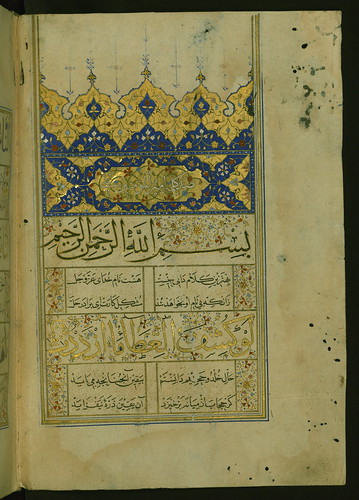
Illuminated Manuscript of One Hundred Sayings, Opening decorated page with headpiece, Walters Art Museum, Ms. W.615, fol.1b, originally uploaded by Walters Art Museum Illuminated Manuscripts.
This beautifully illuminated manuscript contains One hundred sayings, known in Arabic as Mi’at kalimah and in Persian as Ṣad kalimah, attribted to of ʿAlī ibn Abī Ṭālib, the fourth caliph of Islam, as well as a Persian paraphrase (dubayt) by Rashīd al-Dīn Muḥammad al-Balkhī, known as al-Waṭwāṭ (Vaṭvāṭ) (d. ca. 578 AH / 1182 CE). This polychrome text, using a number of scripts, was executed by an anonymous artist most probably in the 9th AH / 15th century.
See this manuscript page by page at the Walters Art Museum website:
art.thewalters.org/viewwoa.aspx?id=5052
Friday, January 21, 2011
Five poems (quintet), Walters Art Museum, Ms. W.624, fol.51a
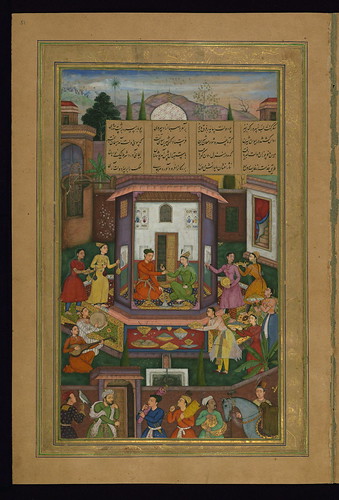
Five poems (quintet), Walters Art Museum, Ms. W.624, fol.51a, originally uploaded by Walters Art Museum Illuminated Manuscripts.
This is a deluxe copy of the Quintet (Khamsah) of Amīr Khusraw Dihlavī (d.725 AH /1325 CE). Although now incomplete, this manuscript was penned in nastaʿlīq script by the famous late 16th century Mughal calligrapher Muḥammad Ḥusayn Zarrīn Qalam al-Kashmīrī and decorated by a number of illuminators and painters. Its illustrations are signed by eleven painters: Laʿl (Lāl), Manūhar, Sānwalah, Farrukh, Alīqulī, Dharamdās, Narsing, Jagannāth, Miskīnā, Mukund, and Sūrdās Gujarātī. On the other hand, its headpieces and a medallion are inscribed with the names of Ḥusayn Naqqāsh, Manṣūr Naqqāsh, Khvājah Jān Shīrāzī, and Luṭf Allāh Muẕahhib. The codex has beautifully decorated borders with vegetal, bird, animal motifs and human figures. The figures are portrayed in various traditional activities such as praying, reading and hunting. Shīrīn entertains Khusraw.
Tuesday, January 18, 2011
Illuminated Manuscript Turkish version of Sindbadnama, Walters Art Museum Ms. W.662, fol. 12a
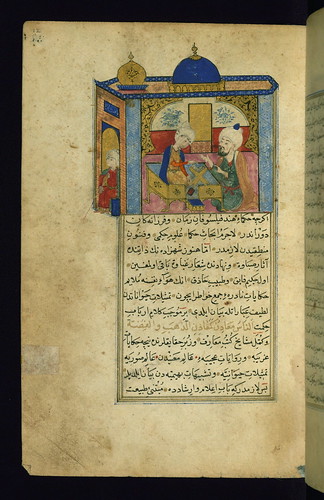
Illuminated Manuscript Turkish version of Sindbadnama, Walters Art Museum Ms. W.662, fol. 12a, originally uploaded by Walters Art Museum Illuminated Manuscripts.
Tuḥfet ül-aḫyār. Folio from an Ottoman Turkish version of the well-known story of Sindbad (Sindbādnāmah) made from the Persian by ʿAbdülkerīm bin Muḥammed during the reign of Sultan Sulayman (Soliman) (reg.926 AH / 1520 CE - 974 AH / 1566 CE) and entitled Tuḥfet ül-aḫyār. This anonymous copy contains six illustrations made in the 10th century AH /16th CE.
See this manuscript page by page at the Walters Art Museum website:
art.thewalters.org/viewwoa.aspx?id=35391
Sunday, January 16, 2011
Five poems (quintet), Walters Art Museum Ms. W.666, fol. 51b

Five poems (quintet), Walters Art Museum Ms. W.666, fol. 51b, originally uploaded by Walters Art Museum Illuminated Manuscripts.
A mufti, having heard a complaint from a mother about her son-in-law’s inability to consummate his marriage to her daughter, giving sexual advice. Leaf from an illustrated copy of the five poems (quintet, Ḫamse) of the Ottoman Turkish author ʿAṭāʾullāh bin Yaḥyá ʿAṭāʾī (d.1044 AH / 1634 CE). Copied in 1133 AH / 1721 CE this rare codex contains 38 miniatures.
Illuminated Manuscript Collected works (Kulliyat), Walters Art Museum Ms. 617, fol. 2a
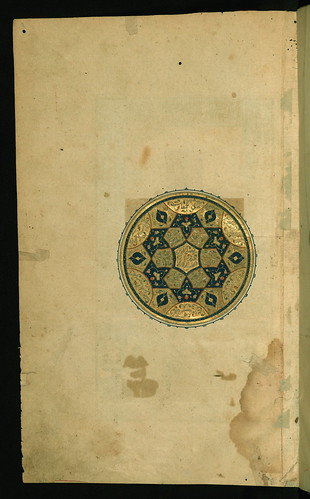
Illuminated Manuscript Collected works (Kulliyat), Walters Art Museum Ms. 617, fol. 2a, originally uploaded by Walters Art Museum Illuminated Manuscripts.
An illuminated and illustrated copy of the collected works of Sa`di (d.691/1292) (Kullīyāt-i Saʿdī) containing, among others, his Gulistān and Bustān. The present manuscript was penned by an anonymous calligrapher in Shiraz (Iran) in 934 AH / 1527 CE. Illuminated medallion with table of contents.
See this manuscript page by page at the Walters Art Museum website:
art.thewalters.org/viewwoa.aspx?id=22469
Saturday, January 15, 2011
Illuminated Manuscript, Map of the port of Brindisi (Parindīs) from Book on Navigation, Walters Art Museum Ms. W.658, fol.205a
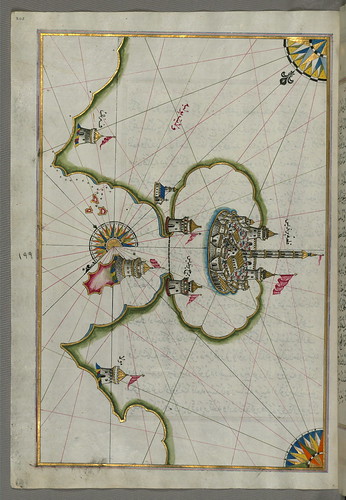
Illuminated Manuscript, Map of the port of Brindisi (Parindīs) from Book on Navigation, Walters Art Museum Ms. W.658, fol.205a, originally uploaded by Walters Art Museum Illuminated Manuscripts.
Originally composed in 932 AH / 1525 CE and dedicated to Sultan Süleyman I ("The Magnificent"), this great work by Piri Reis (d. 962 AH / 1555 CE) on navigation was later revised and expanded. The present manuscript, made mostly in the late 11th AH / 17th CE century, is based on the later expanded version with some 240 exquisitely executed maps and portolan charts. They include a world map (fol.41a) with the outline of the Americas, as well as coastlines (bays, capes, peninsulas), islands, mountains and cities of the Mediterranean basin and the Black Sea. The work starts with the description of the coastline of Anatolia and the islands of the Aegean Sea, the Peloponnese peninsula and eastern and western coasts of the Adriatic Sea. It then proceeds to describe the western shores of Italy, southern France, Spain, North Africa, Palestine, Israel, Lebanon, Syria, western Anatolia, various islands north of Crete, Sea of Marmara, Bosporus and the Black Sea. It ends with a map of the shores of the the Caspian Sea.
Wednesday, January 12, 2011
The inhabitants of Osh (Ūsh) drive the enemy out with sticks and clubs and hold the town for Babur, from Illuminated manuscript Baburnama (Memoirs of Babur), Walters Art Museum Ms. W.596, fol. 25b
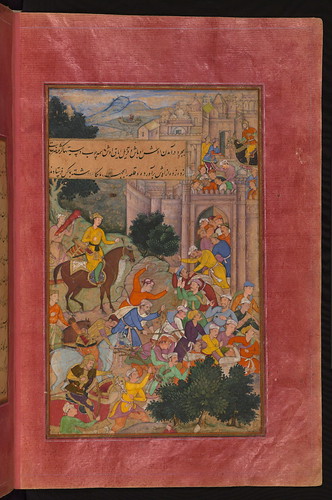
The inhabitants of Osh (Ūsh) drive the enemy out with sticks and clubs and hold the town for Babur, from Illuminated manuscript Baburnama (Memoirs of Babur), Walters Art Museum Ms. W.596, fol. 25b, originally uploaded by Walters Art Museum Illuminated Manuscripts.
Written originally in Chaghatay Turkish and later translated into Persian, Bāburnāmah is the story of a Timurid ruler of Fergana (Central Asia), Ẓahīr al-Dīn Muḥammad Bābur (866 AH /1483 CE - 937 AH / 1530 CE), who conquered northern India and established the Mughal Empire. The present codex, being a fragment of a dispersed copy, was executed most probably in the late 10th AH /16th CE century. It contains 30 mostly full-page miniatures in fine Mughal style by at least two different artists. Another major fragment of this work (57 folios) is in the State Museum of Eastern Cultures, Moscow.
See this manuscript page by page at the Walters Art Museum website:
art.thewalters.org/viewwoa.aspx?id=1759
Sunday, January 9, 2011
Five poems (quintet), Walters Art Museum Ms. W.607, fol. 17a
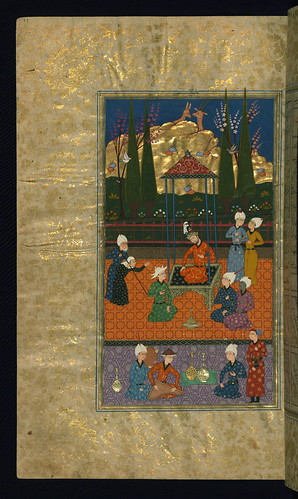
Five poems (quintet), Walters Art Museum Ms. W.607, fol. 17a, originally uploaded by Walters Art Museum Illuminated Manuscripts.
This is an illustrated copy of four of the five poems that comprise the Khamsah of Niẓāmī Ganjavī (d.605 AH / 1209 CE). It does not include Laylá va Majnūn. The text was copied by a certain Yādkār the Calligrapher (al-Kātib) in 935 AH / 1529 CE, most probably in Safavid Iran. An illuminated double-page composition opens the manuscript and each poem is initiated with a decorative headpiece. The miniatures appear to have been repainted at some point in the manuscript’s history. Their date and provenance are open to question. The textblock is bound in late Zand lacquer covers with scenes depicting Bahrām Gūr hunting and Khusraw watching Shīrīn bathing. An old woman approaches the throne of Sultan Sanjar to tell of her oppression.
See this manuscript page by page at the Walters Art Museum website:
art.thewalters.org/viewwoa.aspx?id=17718This is an illustrated copy of four of the five poems that comprise the Khamsah of Niẓāmī Ganjavī (d.605 AH / 1209 CE). It does not include Laylá va Majnūn. The text was copied by a certain Yādkār the Calligrapher (al-Kātib) in 935 AH / 1529 CE, most probably in Safavid Iran. An illuminated double-page composition opens the manuscript and each poem is initiated with a decorative headpiece. The miniatures appear to have been repainted at some point in the manuscript’s history. Their date and provenance are open to question. The textblock is bound in late Zand lacquer covers with scenes depicting Bahrām Gūr hunting and Khusraw watching Shīrīn bathing. An old woman approaches the throne of Sultan Sanjar to tell of her oppression.
See this manuscript page by page at the Walters Art Museum website:
art.thewalters.org/viewwoa.aspx?id=17718
